Briggs & Stratton 01654 User Manual [en, es, fr]
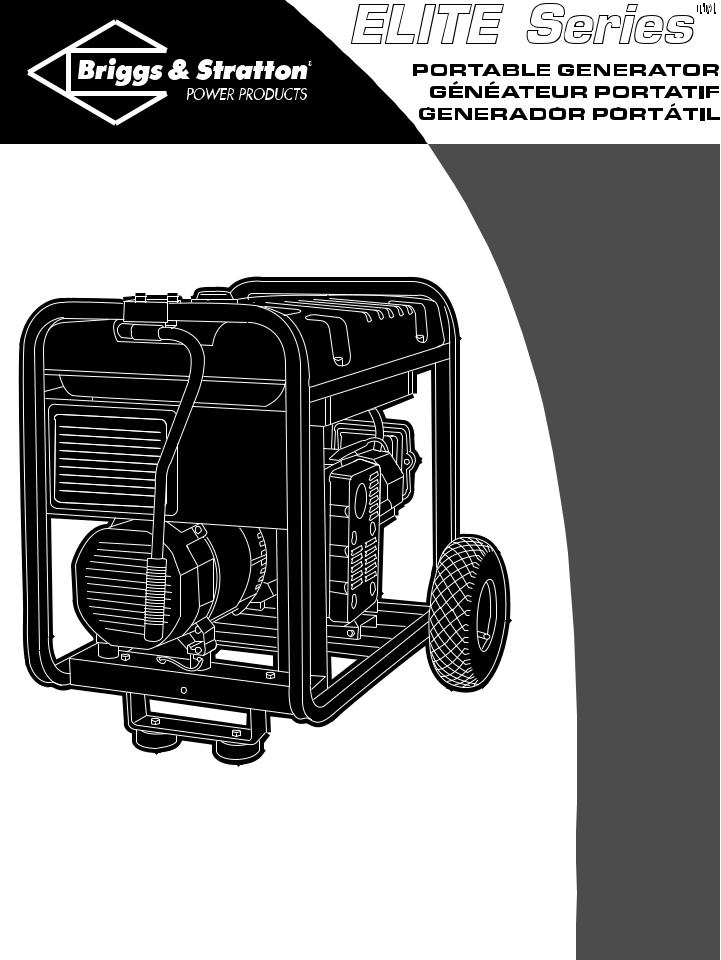
Owner’s Manual
Manuel de l'utilisateur
Manual del Propietario
Model 01654 Shown
Questions? Help is just a moment away!
Vous avez des questions? Vous n'avez pas besoin d'aller loin pour trouver de l'aide! Preguntas? La ayuda es justa un momento lejos!
Call: Generator Helpline - 1-800-743-4115 M-F 8-5 CT
Appelez: Ligne d'assistance de Générateur - 1-800-743-4115 M-F 8-5 CT
Llamada: Generador Helpline - 1-800-743-4115 M-F 8-5 CT
BRIGGS & STRATTON POWER PRODUCTS GROUP, LLC
JEFFERSON,WISCONSIN, U.S.A.
01653
(3250W)
01654
(5500W)
01892
(5000W)
01893
(6000W)
Manual No. 191958GS
Revision 1 (01/30/2003)

Portable Generator
TABLE OF CONTENTS
Safety Rules. . . . . . . . . . . . . . . . . . . . . . . . . . . . . . . . . . 2-4
Assembly. . . . . . . . . . . . . . . . . . . . . . . . . . . . . . . . . . . . 5-7
Operation . . . . . . . . . . . . . . . . . . . . . . . . . . . . . . . . . . 8-11
Maintenance . . . . . . . . . . . . . . . . . . . . . . . . . . . . . . . . . . 12
Storage . . . . . . . . . . . . . . . . . . . . . . . . . . . . . . . . . . . . . . 13
Troubleshooting . . . . . . . . . . . . . . . . . . . . . . . . . . . . . . . 14
Warranty . . . . . . . . . . . . . . . . . . . . . . . . . . . . . . . . . . . . 15
EQUIPMENT
DESCRIPTION
Read this manual carefully and become familiar with your generator. Know its applications, its limitations and any hazards involved.
The generators are an engine–driven, revolving field, alternating current (AC) generator. It was designed to supply electrical power for operating compatible electrical lighting, appliances, tools and motor loads.The generator’s revolving field is driven at about 3,600 rpm by a single-cylinder engine.
CAUTION! DO NOT exceed the generator’s wattage/amperage capacity. See “Don’t Overload Generator” on page 11.
Every effort has been made to ensure that information in this manual is accurate and current. However, we reserve the right to change, alter or otherwise improve the product and this document at any time without prior notice.
The Emission Control System for this generator is warranted for standards set by the Environmental Protection Agency. For warranty information refer to the engine owner’s manual.
SAFETY RULES
This is the safety alert symbol. It is used to alert you to potential personal injury hazards. Obey all safety messages that follow this symbol to avoid possible injury or death.
The safety alert symbol ( ) is used with a signal word (DANGER, CAUTION,WARNING), a pictorial and/or a safety message to alert you to hazards. DANGER indicates a hazard which, if not avoided, will result in death or serious injury. WARNING indicates a hazard which, if not avoided, could result in death or serious injury. CAUTION indicates a hazard which, if not avoided, might result in minor or moderate injury. CAUTION, when used without the alert symbol, indicates a situation that could result in equipment damage. Follow safety messages to avoid or reduce the risk of injury or death.
) is used with a signal word (DANGER, CAUTION,WARNING), a pictorial and/or a safety message to alert you to hazards. DANGER indicates a hazard which, if not avoided, will result in death or serious injury. WARNING indicates a hazard which, if not avoided, could result in death or serious injury. CAUTION indicates a hazard which, if not avoided, might result in minor or moderate injury. CAUTION, when used without the alert symbol, indicates a situation that could result in equipment damage. Follow safety messages to avoid or reduce the risk of injury or death.
In the State of California a spark arrester is required by law (Section 4442 of the California Public Resources Code). Other states may have similar laws. Federal laws apply on federal lands. If you equip the muffler with a spark arrester, it must be maintained in effective working order.
 WARNING
WARNING
The engine exhaust from this product contains chemicals known to the State of California to cause cancer, birth defects, or other reproductive harm.
2
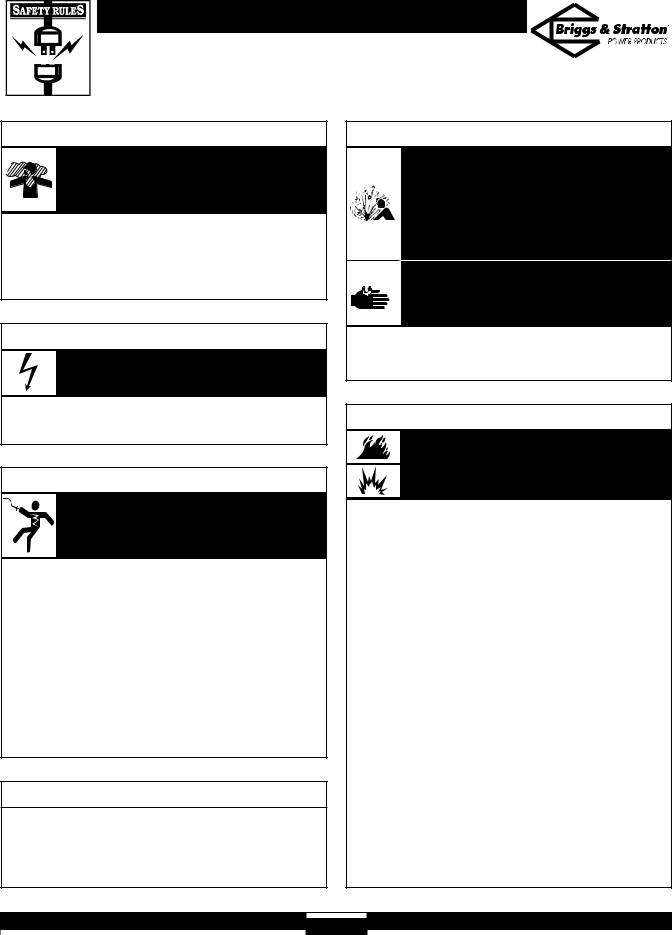
Portable Generator
 DANGER
DANGER
Running generator gives off carbon monoxide, an odorless, colorless, poison gas.
Breathing carbon monoxide will cause nausea, fainting or death.
•Operate generator ONLY outdoors.
•Keep at least 2 feet of clearance on all sides of generator for adequate ventilation.
•DO NOT operate generator inside any building or enclosure, including the generator compartment of a recreational vehicle (RV).
 DANGER
DANGER
Failure to properly ground generator can result in electrocution, especially if the generator is equipped with a wheel kit.
•National Electric Code requires generator to be properly grounded to an approved earth ground. Call an electrician for local grounding requirements.
 DANGER
DANGER
Generator produces powerful voltage.
Failure to isolate generator from power utility can result in death or injury to electric utility workers due to backfeed of electrical energy.
•When using generator for backup power, notify utility company. Use approved transfer equipment to isolate generator from electric utility.
•Use a ground circuit fault interrupter (GFCI) in any damp or
highly conductive area, such as metal decking or steel work.
•DO NOT touch bare wires or receptacles.
•DO NOT use generator with electrical cords which are worn, frayed, bare or otherwise damaged.
•DO NOT operate generator in the rain.
•DO NOT handle generator or electrical cords while standing
in water, while barefoot, or while hands or feet are wet.
•DO NOT allow unqualified persons or children to operate or service generator.
 WARNING
WARNING
•This generator does not meet U. S. Coast Guard Regulation 33CFR-183 and should not be used on marine applications.
•Failure to use the appropriate U. S. Coast Guard approved generator could result in bodily injury and/or property damage.
 DANGER
DANGER
Storage batteries give off explosive hydrogen gas during recharging.
Hydrogen gas stays around battery for a long time after battery has been charged.
Slightest spark will ignite hydrogen and cause explosion.
You can be blinded or severely injured.
Battery electrolyte fluid contains acid and is  extremely caustic.
extremely caustic.
Contact with battery fluid will cause severe chemical burns.
•DO NOT allow any open flame, spark, heat, or lit cigarette during and for several minutes after charging a battery.
•Wear protective goggles, rubber apron, and rubber gloves.
 WARNING
WARNING
Fuel and its vapors are extremely flammable and explosive.
Fire or explosion can cause severe burns or death.
WHEN ADDING FUEL
• Turn generator OFF and let it cool at least 2 minutes before removing gas cap. Loosen cap slowly to relieve pressure in tank.
•Fill fuel tank outdoors.
•DO NOT overfill tank.Allow space for fuel expansion.
•Keep fuel away from sparks, open flames, pilot lights, heat, and other ignition sources.
•DO NOT light a cigarette or smoke.
WHEN OPERATING EQUIPMENT
•DO NOT tip engine or equipment at angle which causes fuel to spill.
•This generator is not for use in mobile equipment or marine applications.
WHEN TRANSPORTING OR REPAIRING EQUIPMENT
•Transport/repair with fuel tank EMPTY or with fuel shutoff valve OFF.
•Disconnect spark plug wire.
WHEN STORING FUEL OR EQUIPMENT WITH FUEL IN TANK
•Store away from furnaces, stoves, water heaters, clothes dryers or other appliances that have pilot light or other ignition source because they can ignite fuel vapors.
3
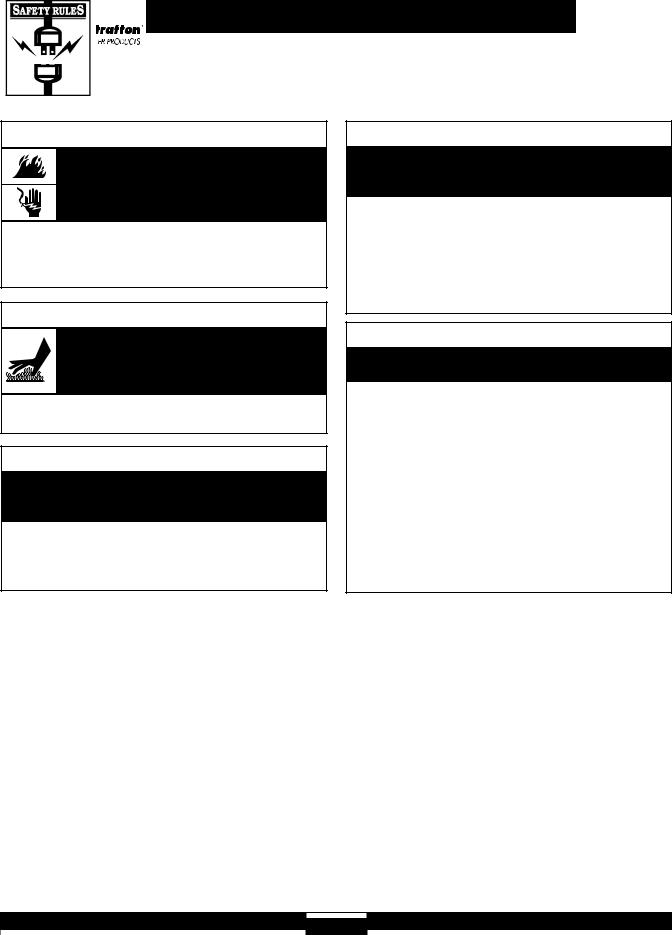
Portable Generator
 WARNING
WARNING
Unintentional sparking can result in fire or electric shock.
WHEN ADJUSTING OR MAKING REPAIRS TO YOUR GENERATOR
•Disconnect the spark plug wire from the spark plug and place the wire where it cannot contact spark plug.
 WARNING
WARNING
Running engines produce heat.Temperature of muffler and nearby areas can reach or exceed 150°F (65°C).
Severe burns can occur on contact.
•DO NOT touch hot surfaces.
•Allow equipment to cool before touching.
 CAUTION
CAUTION
Excessively high operating speeds increase risk of injury and damage to generator.
Excessively low speeds impose a heavy load.
•DO NOT tamper with governed speed. Generator supplies correct rated frequency and voltage when running at governed speed.
•DO NOT modify generator in any way.
CAUTION
Exceeding generators wattage/amperage capacity can damage generator and/or electrical devices connected to it.
•See “Don’t Overload Generator” on page 11.
•Start generator and let engine stabilize before connecting electrical loads.
•Connect electrical loads in OFF position, then turn ON for operation.
•Turn electrical loads OFF and disconnect from generator before stopping generator.
CAUTION
Improper treatment of generator can damage it and shorten its life.
•Use generator only for intended uses.
•If you have questions about intended use, ask dealer or call 1-800-743-4115.
•Operate generator only on level surfaces.
•DO NOT expose generator to excessive moisture, dust, dirt, or corrosive vapors.
•DO NOT insert any objects through cooling slots.
•If connected devices overheat, turn them off and disconnect them from generator.
•Shut off generator if:
-electrical output is lost;
-equipment sparks, smokes, or emits flames; -unit vibrates excessively.
4
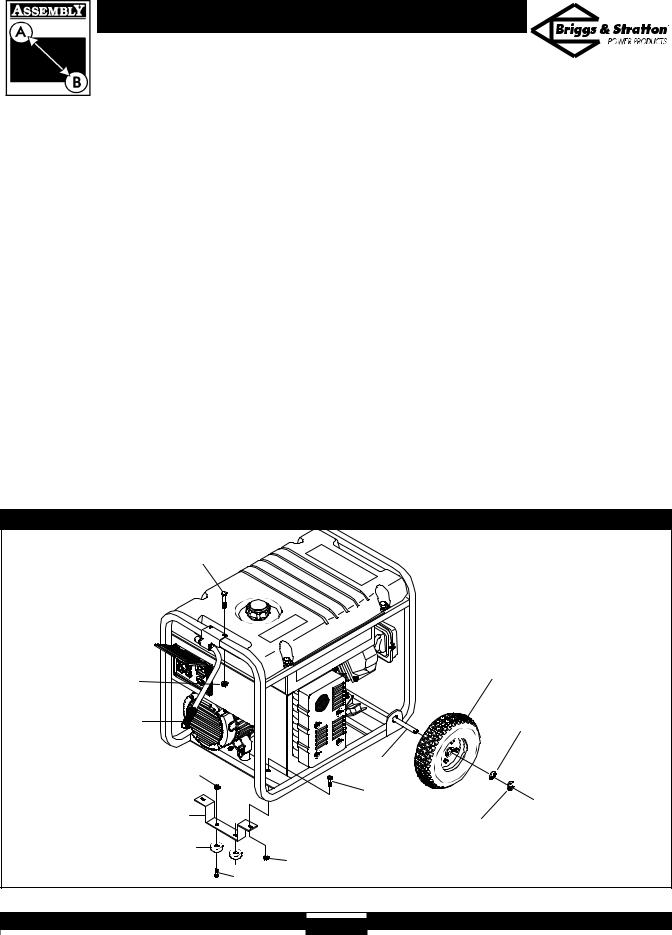
Portable Generator
ASSEMBLY
Your generator requires some assembly and is ready for use after it has been properly serviced with the recommended oil and fuel.
If you have any problems with the assembly of your generator, please call the generator helpline at 1-800-743-4115. If calling for assistance, please have the model, revision, and serial number from the data tag available.
INSTALL WHEEL KIT
NOTE: If your unit is supplied with a 10” wheel kit use the following instructions. If your unit is supplied with an 8” wheel kit use the instructions on page 6.
NOTE: While the wheel kit is designed to greatly improve the portability of your generator, it is not intended for over-the-road use.
You will need a socket wrench with 1/2" or 13mm sockets and a needle-nose pliers to install this kit.
Install the 10” Wheel Kit as Follows
1.Place the bottom of the generator cradle on a flat, even surface.Temporarily place unit on blocks to ease assembly.
Figure 1 — Install Wheel Kit
2.Slide axle through both axle mounting brackets on cradle frame, as shown in Figure 1.
3.Slide a wheel over the axle.
NOTE: Be sure to install both wheels with the air pressure valve on the outboard side.
4.Place the e-ring onto the groove in the axle.You may add the flat washer if desired.
NOTE: Use retaining pins instead of e-clip, if applicable.
5.Place one end of the needle nose pliers on the bottom of the axle and the other end of the pliers on top of the e-ring. Seat the e-ring by pressing the pliers closed.
6.Repeat step 3 through 5 to secure second wheel.
7.Remove the temporary blocks.
8.Attach the vibration mounts to the support leg with 30mm capscrews and lock nuts.
9.To aid support leg assembly, rest generator on cradle, engine end down. Remove the existing hardware from the left unit vibration mount with 13mm wrench. Use the same hardware to attach the support leg.
10.Attach the other side of the support leg with a 20mm cap screw and lock nut. Rest generator on wheels and support leg.
Cap Screw
Hex Nut
Handle Assembly
Use existing hardware
to attach left side of Hex Nut support leg to unit
Support Leg
Vibration Mount
Hex Nut
Cap Screw
Wheel
Flat Washer
Axle
Cap Screw
E-Ring
5
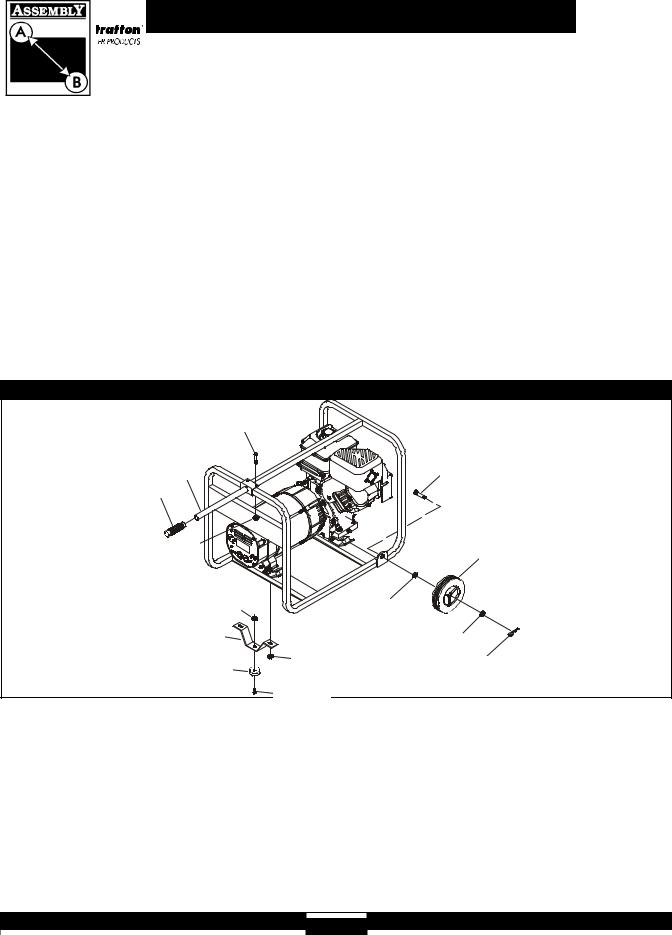
Portable Generator
11.If equipped, center the handle bracket on generator frame at support leg end of cradle, as shown.
12.Attach handle bracket with two M8 x 45mm cap screws and two locking hex nuts.
13.Check that all fasteners are tight and the tires are inflated to the value marked on the tire or within 15 and 40 psi.
Install the 8” Wheel Kit as Follows
1.Place bottom of generator cradle on a flat surface.
2.Place axle stud through wheel retainer on cradle frame, as shown in Figure 2.
3.Use 15/16” wrench to secure the axle stud to frame with 5/8-18 jam nut.
4.Install the other axle stud in the same manner.
NOTE: Be sure to install wheel with raised hub inboard.
5.Tip unit and install the wheel. Place flat washer over axle stud.
6.Retain wheel on axle stud with retaining pin. Install other wheel on remaining axle shaft the same way.
7.Attach the vibration mount to the mounting leg with a capscrew and lock nut.
8.Remove two front nuts from vibration mount on unit with 13mm wrench. Use these nuts to retain the mounting leg.
9.Center the lifting handle on generator end of cradle. Attach the handle using two 13mm wrenches with two capscrews and two hex nuts.
Figure 2 — Installing the Wheel Kit
Capscrew |
|
|
Handle |
|
Axle Stud |
Grip |
|
|
|
|
|
Nut |
|
Wheel |
|
|
|
Nut |
Jam Nut |
|
Mounting Leg |
Use Existing Fasteners |
Washer |
|
Retaining Pin |
|
Vibration Mount |
to Secure Leg |
|
|
Capscrew |
|
6
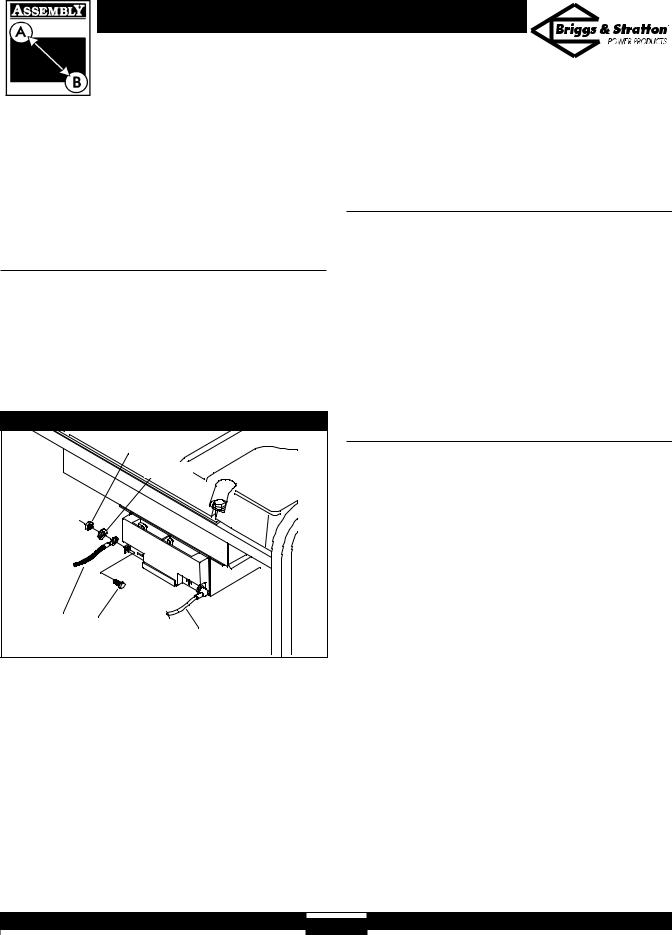
Portable Generator
ELECTRIC START
Your unit may be equipped with electric start capability but can be started manually. If you choose not to use the electric start feature, you do not need to install the battery. If your unit does not have electric start, ignore this section.
Check Battery / Attach Negative
Battery Wire
The sealed battery on the generator is fully charged and pre–installed except for the negative (black) battery cable.
To install:
•Cut off tie wrap securing loose end of negative (black) cable.
•Remove nut and washer on the negative battery terminal.
•Slide the negative battery cable over the screw on the negative terminal (Figure 3).
Figure 3 — Negative Battery Connection
|
Nut |
|
Washer |
Negative |
|
battery |
Screw |
cable |
|
|
Positive battery cable |
•Reattach washer and nut and tighten.
•Verify that the connections to the battery and generator are tight and secure.
BEFORE STARTING THE ENGINE
Add Oil
CAUTION! Any attempt to crank or start the engine before it has been properly filled with the recommended oil may result in an engine failure.
To fill your engine with oil:
•Place generator on a level surface.
•Follow the oil grade recommendations and oil fill instructions given in the engine owner’s manual.
NOTE: The generator’s revolving field rides on a prelubricated and sealed ball bearing that requires no additional lubrication for the life of the bearing.
Add Fuel
 WARNING! NEVER fill fuel tank indoors. NEVER fill fuel tank when engine is running or hot.Allow unit to cool for two minutes before refueling. DO NOT light a cigarette or smoke when filling the fuel tank.
WARNING! NEVER fill fuel tank indoors. NEVER fill fuel tank when engine is running or hot.Allow unit to cool for two minutes before refueling. DO NOT light a cigarette or smoke when filling the fuel tank.
 WARNING! DO NOT overfill the fuel tank. Always allow room for fuel expansion.
WARNING! DO NOT overfill the fuel tank. Always allow room for fuel expansion.
•Place generator on a level surface.
•Follow the fuel grade recommendations and fuel fill instructions given in the engine owner’s manual.
7
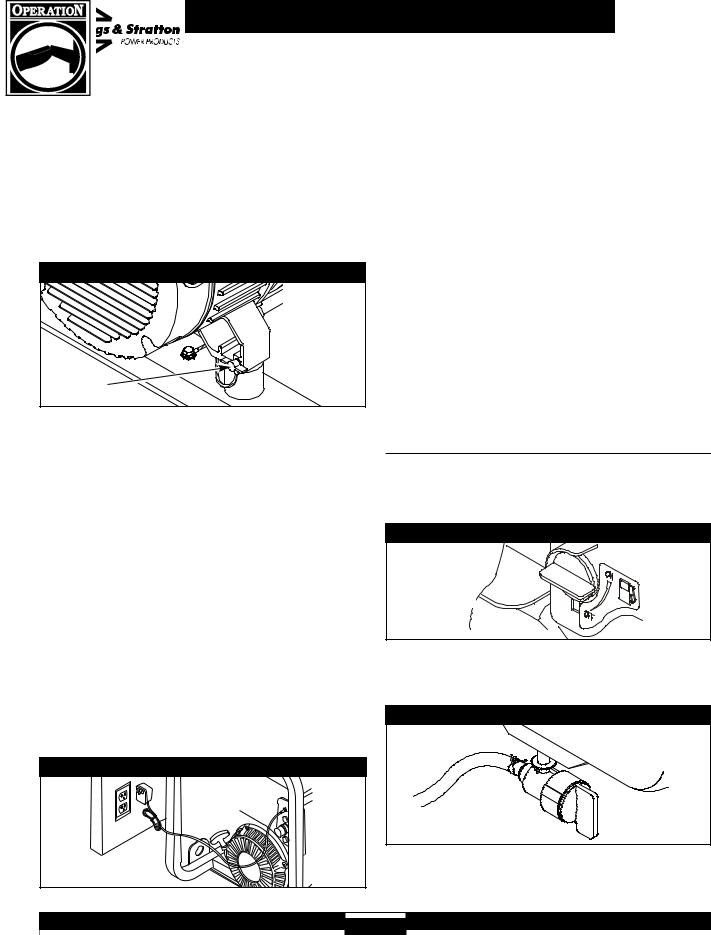
GROUNDING THE
Portable Generator
•Unplug the charger from the unit and the wall outlet when generator is being started and while it is in operation.
GENERATOR
The National Electrical Code requires that the frame and external electrically conductive parts of this generator be properly connected to an approved earth ground. Local electrical codes may also require proper grounding of the unit. For that purpose, a GROUNDING FASTENER is provided on the generator end (Figure 4).
Figure 4 — Grounding Fastener
Grounding |
Fastener |
Generally, connecting a No. 12 AWG (American Wire Gauge) stranded copper wire to the grounding fastener and to an earth–driven copper or brass grounding rod (electrode) provides adequate protection against electrical shock. Be careful to keep the grounding wire attached after connecting the stranded copper wire. However, local codes may vary widely. Consult with a local electrician for grounding requirements in your area.
Properly grounding the generator helps prevent electrical shock if a ground fault condition exists in the generator or in connected electrical devices, especially when the unit is equipped with a wheel kit. Proper grounding also helps dissipate static electricity, which often builds up in ungrounded devices.
BATTERY CHARGER
If equipped, use battery float charger jack to keep the starting battery charged and ready for use. Battery charging should be done in a dry location, such as inside a garage.
•Plug the charger into the unit’s “Battery Float Charger” jack, which is located on the starter switch (Figure 5). Plug battery charger into a 120 Volt AC wall receptacle.
Figure 5 — Battery Charger Jack
•Keep this charger plugged in when generator is not in use to prolong battery life.The charger has a built in float equalizer and will not overcharge the battery, even when plugged in for an extended period of time.
IMPORTANT: See “Battery Maintenance” on page 12 for additional information.
OPERATING THE
GENERATOR
 CAUTION! NEVER start or stop the engine with electrical loads connected to the receptacles AND with the connected devices turned ON.
CAUTION! NEVER start or stop the engine with electrical loads connected to the receptacles AND with the connected devices turned ON.
IMPORTANT: Always unplug the battery float charger before starting the generator.
Starting the Engine
Disconnect all electrical loads from the generator. Use the following start instructions:
•For models with the fuel valve built into the engine, turn the fuel valve to the “On” position (Figure 6).
Figure 6 — Fuel Valve
Fuel Valve is shown in the On position
•For models with an overhead fuel tank, turn the fuel valve to the “On” position (Figure 7).The fuel valve handle should be vertical (pointing toward the ground) for fuel to flow.
Figure 7 — Fuel Valve
Fuel Valve is shown in the On position
•Start the engine according to instructions given in the engine owner’s manual.
8
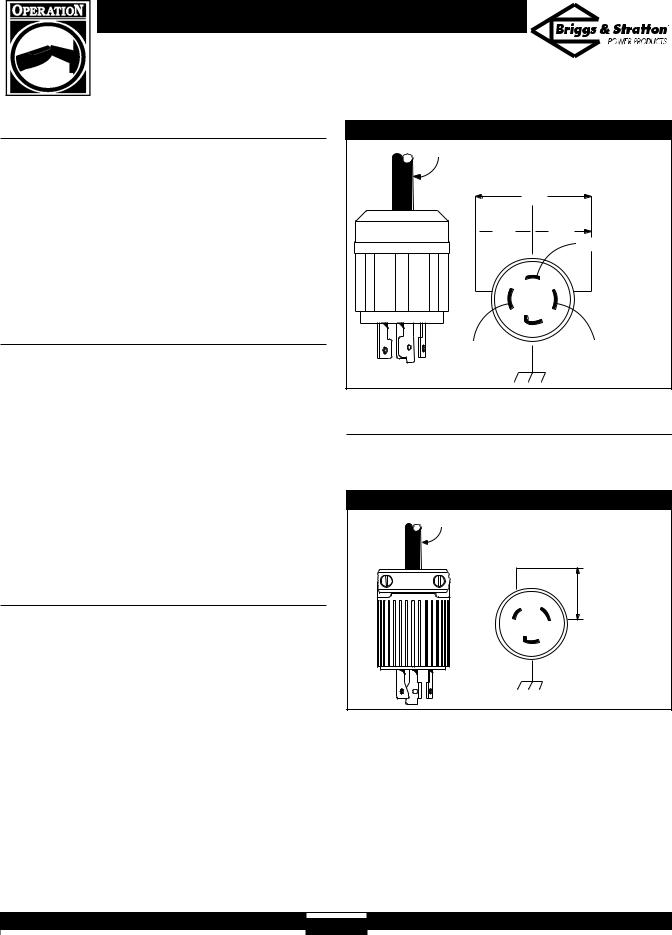
Portable Generator
Connecting Electrical Loads
•Let engine stabilize and warm up for a few minutes after starting.
•Plug in and turn on the desired 120 and/or 240 Volt AC, single phase, 60 Hz electrical loads.
•DO NOT connect 240 Volt loads to the 120 Volt duplex receptacles.
•DO NOT connect 3–phase loads to the generator.
•DO NOT connect 50 Hz loads to the generator.
•DO NOT OVERLOAD THE GENERATOR. See “Don’t Overload the Generator” on page 11.
Stopping the Engine
•Unplug all electrical loads from generator panel receptacles. Never start or stop engine with electrical devices plugged in and turned ON.
Figure 8 — 120/240 Volt AC, 30 Amp Receptacle
4-Wire Cord Set
240V
 120V
120V  120V
120V
W (Neutral)
Y (Hot) |
X (Hot) |
NEMA L14-30 |
Ground (Green) |
•Let engine run at no-load for several minutes to stabilize the internal temperatures of engine and generator.
•Turn engine off according to instructions given in the engine owner’s manual.
•Move the fuel valve to the “Off” position.
RECEPTACLES
The generator will be equipped with one or more of the following receptacles:
120/240 Volt AC, 30 Amp, Locking
Receptacle
Use a NEMA L14–30 plug with this receptacle. Connect a 4–wire cord set rated for 250 Volt AC loads at 30 Amps (or greater) (Figure 8).You can use the same 4–wire cord if you plan to run a 120 Volt load.
This receptacle powers 120/240 Volt AC, 60 Hz, single phase loads requiring up to 6,000 watts of power (6.0 kW) at 30 Amps for 120 Volts or 240 Volts.The outlet is protected by a push–to–reset circuit breaker.
 CAUTION! Although this outlet states it has a 120/240 Volt 30 Amp rating (up to 7,200 watts), the generator may only be rated for up to 6,000 watts. Powering loads that exceed the wattage/amperage capacity of the generator can damage it or cause serious injuries.
CAUTION! Although this outlet states it has a 120/240 Volt 30 Amp rating (up to 7,200 watts), the generator may only be rated for up to 6,000 watts. Powering loads that exceed the wattage/amperage capacity of the generator can damage it or cause serious injuries.
120 Volt AC, 30 Amp Locking
Receptacle
Use a NEMA L5-30 plug with this receptacle. Connect a 3-wire cord set rated for 125 Volts AC at 30 Amps to the plug (Figure 9).
Figure 9 — 120 Volt AC, 30 Amp, Locking Receptacle
3-Wire Cord Set
NEMA L5-30
Neutral
120V
Hot
Ground (Green)
Use this receptacle to operate 120 Volt AC, 60 Hz, single phase loads requiring up to 3,600 watts (3.6 kW) of power at 30 Amps.The outlet is protected by a push-to-reset circuit breaker.
 CAUTION! Although this outlet is rated for 120 Volt 30 Amp (up to 3,600 watts), the generator may only be rated for 3,250 watts at 27 Amps. Powering loads that exceed the wattage/amperage capacity of the generator can damage it or cause serious injuries.
CAUTION! Although this outlet is rated for 120 Volt 30 Amp (up to 3,600 watts), the generator may only be rated for 3,250 watts at 27 Amps. Powering loads that exceed the wattage/amperage capacity of the generator can damage it or cause serious injuries.
9
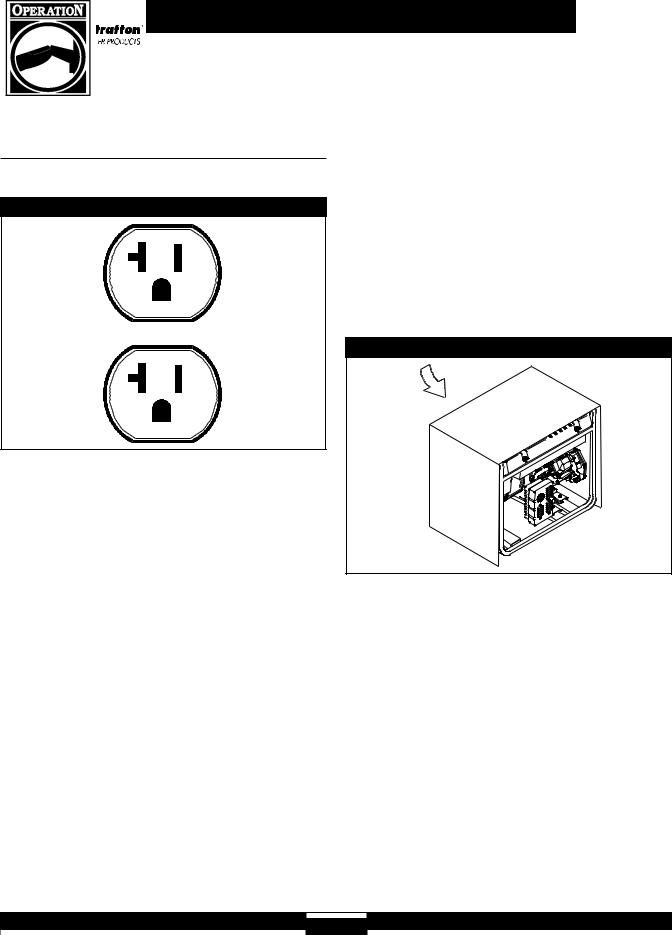
Portable Generator
120 Volt AC, 20 Amp, Duplex
Receptacles
Each duplex receptacle (Figure 10) is protected against overload by a push–to–reset circuit breaker.
Figure 10 — 120 Volt, 20 Amp Duplex Receptacle
Use each receptacle to operate 120 Volt AC, single–phase, 60 Hz electrical loads requiring up to 2,400 watts (2.4 kW) at 20 Amps of current. Use cord sets that are rated for 125 Volt AC loads at 20 Amps (or greater).
 CAUTION! These outlets are rated at 120 Volt 20 Amps each (up to 80 Amps).The generator may only be rated for up to 27 Amps. Powering loads that exceed the wattage/amperage capacity of the generator can damage it or cause serious injuries.
CAUTION! These outlets are rated at 120 Volt 20 Amps each (up to 80 Amps).The generator may only be rated for up to 27 Amps. Powering loads that exceed the wattage/amperage capacity of the generator can damage it or cause serious injuries.
COLD WEATHER
OPERATION
Under certain weather conditions (temperatures below 40°F [4°C] and a high dew point), your generator may experience icing of the carburetor and/or the crankcase breather system.
Build a structure that will enclose three sides and the top of the generator:
•Make sure entire muffler-side of generator is exposed. Note that your generator may appear different from that shown in Figure 11.
Figure 11 — Permanent Cold Weather Shelter
Wind
•Ensure a minimum of two feet clearance between open side of box and nearest object.
•Face exposed end away from wind and elements.
•Enclosure should hold enough heat created by the generator to prevent problems.
 CAUTION! NEVER run unit indoors. DO NOT enclose generator any more than shown. Remove generator from shelter when temperature is above 40°F [4°C].
CAUTION! NEVER run unit indoors. DO NOT enclose generator any more than shown. Remove generator from shelter when temperature is above 40°F [4°C].
10
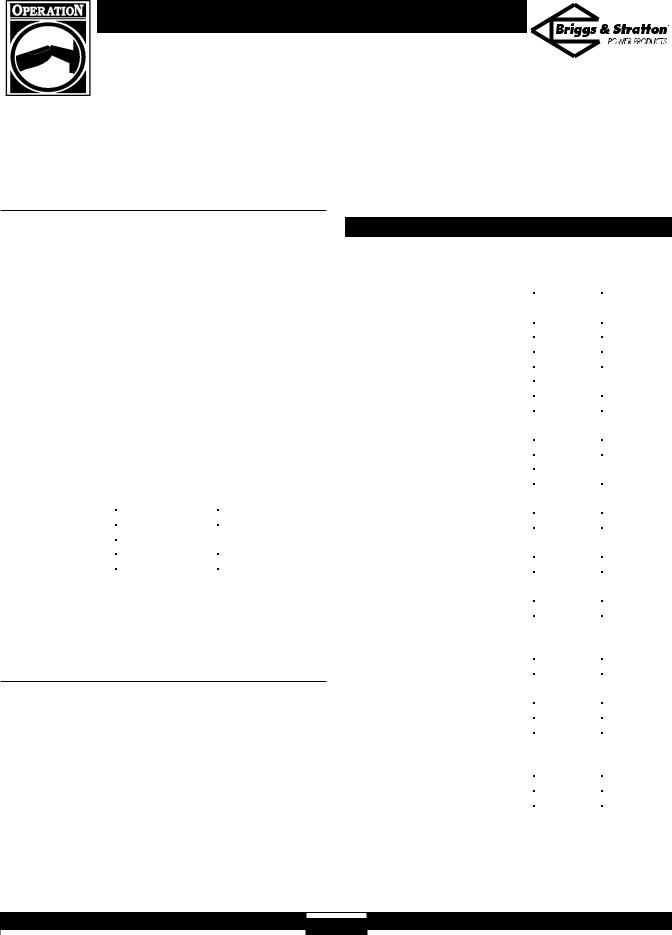
Portable Generator
DON'T OVERLOAD GENERATOR
Capacity
4.Plug in and turn on the next load.
5.Again, permit the generator to stabilize.
6.Repeat steps 4 and 5 for each additional load.
NEVER add more loads than the generator capacity.Take special care to consider surge loads in generator capacity, as described above.
You must make sure your generator can supply enough rated (running) and surge (starting) watts for the items you will power at the same time. Follow these simple steps:
1.Select the items you will power at the same time.
2.Total the rated (running) watts of these items.This is the amount of power your generator must produce to keep your items running. See Figure 12.
3.Estimate how many surge (starting) watts you will need. Surge wattage is the short burst of power needed to start electric motor-driven tools or appliances such as a circular saw or refrigerator. Because not all motors start at the same time, total surge watts can be estimated by adding only the item(s) with the highest additional surge watts to the total rated watts from step 2.
Example:
Tool or Appliance |
Rated (Running) |
|
Additional Surge |
||
Watts |
|
|
(Starting) Watts |
||
|
|
|
|||
Window Air |
|
1200 |
|
|
1800 |
Conditioner |
|
|
|
|
|
Refrigerator |
|
800 |
|
|
1600 |
Deep Freezer |
|
500 |
|
|
500 |
Television |
|
500 |
|
|
- |
Light (75 Watts) |
|
75 |
|
|
- |
|
3075 Total |
|
1800 Highest |
||
|
Running Watts |
|
Surge Watts |
||
Total Rated (Running) Watts |
|
= 3075 |
|
||
Highest Additional Surge Watts |
= 1800 |
|
|||
Total Generator Output Required |
= 4875 |
|
|||
Power Management
To prolong the life of your generator and attached devices, it is important to take care when adding electrical loads to your generator.There should be nothing connected to the generator outlets before starting it's engine.The correct and safe way to manage generator power is to sequentially add loads as follows:
1.With nothing connected to the generator, start the engine as described in this manual.
2.Plug in and turn on the first load, preferably the largest load you have.
3.Permit the generator output to stabilize (engine runs smoothly and attached device operates properly.
Figure 12 - Wattage Reference Chart
|
Rated* |
Additional |
|
|
Surge |
||
Tool or Appliance |
(Running) |
||
(Starting) |
|||
|
Watts |
||
|
Watts |
||
|
|
||
Essentials |
|
|
|
Light Bulb - 75 watt |
75 |
- |
|
Deep Freezer |
500 |
500 |
|
Sump Pump |
800 |
1200 |
|
Refrigerator/Freezer - 18 Cu. Ft. |
800 |
1600 |
|
Water Well Pump - 1/3 HP |
1000 |
2000 |
|
Heating/Cooling |
|
|
|
Window AC - 10,000 BTU |
1200 |
1800 |
|
Window Fan |
300 |
600 |
|
Furnace Fan Blower - 1/2 HP |
800 |
1300 |
|
Kitchen |
|
|
|
Microwave Oven - 1000 Watt |
1000 |
- |
|
Coffee Maker |
1500 |
- |
|
Electric Stove - Single Element |
1500 |
- |
|
Hot Plate |
2500 |
- |
|
Family Room |
|
|
|
DVD/CD Player |
100 |
- |
|
VCR |
100 |
- |
|
Stereo Receiver |
450 |
- |
|
Color Television - 27” |
500 |
- |
|
Personal Computer w/17” monitor |
800 |
- |
|
Other |
|
|
|
Security System |
180 |
- |
|
AM/FM Clock Radio |
300 |
- |
|
Garage Door Opener - 1/2 HP |
480 |
520 |
|
Electric Water Heater - 40 Gallon |
4000 |
- |
|
DIY/Job Site |
|
|
|
Quartz Halogen Work Light |
1000 |
- |
|
Airless Sprayer - 1/3 HP |
600 |
1200 |
|
Reciprocating Saw |
960 |
960 |
|
Electric Drill - 1/2 HP |
1000 |
1000 |
|
Circular Saw - 7 1/4” |
1500 |
1500 |
|
Miter Saw - 10” |
1800 |
1800 |
|
Table Planer - 6” |
1800 |
1800 |
|
Table Saw/Radial Arm Saw - 10” |
2000 |
2000 |
|
Air Compressor - 1-1/2 HP |
2500 |
2500 |
*Wattages listed are approximate only. Check tool or appliance for actual wattage.
11

Portable Generator
GENERAL MAINTENANCE RECOMMENDATIONS
The Owner/Operator is responsible for making sure that all periodic maintenance tasks are completed on a timely basis; that all discrepancies are corrected; and that the unit is kept clean and properly stored. NEVER operate a
NOTE: DO NOT use a garden hose to clean generator. Water can enter engine fuel system and cause problems. In addition, if water enters generator through cooling air slots, some of the water will be retained in voids and cracks of the rotor and stator winding insulation.Water and dirt buildup on the generator internal windings will eventually decrease the insulation resistance of these windings.
damaged or defective generator.
Engine Maintenance
See engine owner’s manual for instructions.
 CAUTION! Avoid prolonged or repeated skin contact with used motor oil. Used motor oil has been shown to cause skin cancer in certain laboratory animals.Thoroughly wash exposed areas with soap and water.
CAUTION! Avoid prolonged or repeated skin contact with used motor oil. Used motor oil has been shown to cause skin cancer in certain laboratory animals.Thoroughly wash exposed areas with soap and water.
KEEP OUT OF REACH OF CHILDREN. DON'T POLLUTE. CONSERVE RESOURCES. RETURN USED OIL TO COLLECTION CENTERS.
Battery Maintenance
Other than float charging, described elsewhere, no maintenance is required for the starting battery. Keep the battery and terminals clean and dry.
IMPORTANT: Battery charging should be performed in a dry location, such as inside a garage.
To Clean the Generator
 CAUTION! NEVER insert any object or tool through the air cooling slots, even if the engine is not running.
CAUTION! NEVER insert any object or tool through the air cooling slots, even if the engine is not running.
• Use a damp cloth to wipe exterior surfaces clean.
Generator Maintenance
Generator maintenance consists of keeping the unit clean and dry. Operate and store the unit in a clean dry environment where it will not be exposed to excessive dust, dirt, moisture or any corrosive vapors. Cooling air slots in the generator must not become clogged with snow, leaves or any other foreign material.
•A soft bristle brush may be used to loosen caked on dirt or oil.
•A vacuum cleaner may be used to pick up loose dirt and debris.
•Low pressure air (not to exceed 25 psi) may be used to blow away dirt. Inspect cooling air slots and opening on generator.These openings must be kept clean and unobstructed.
12

Portable Generator
STORAGE
The generator should be started at least once every seven days and allowed to run at least 30 minutes. If this cannot be done and you must store the unit for more than
30 days, use the following guidelines to prepare it for storage.
Generator Storage
•Clean the generator as outlined in “To Clean the Generator.”
•Check that cooling air slots and openings on generator are open and unobstructed.
 CAUTION! Storage covers can be flammable. DO NOT place a storage cover over a hot generator. Let the unit cool for a sufficient time before placing the cover on the unit.
CAUTION! Storage covers can be flammable. DO NOT place a storage cover over a hot generator. Let the unit cool for a sufficient time before placing the cover on the unit.
Engine Storage
See engine owner’s manual for instructions.
Other Storage Tips
•To prevent gum from forming in fuel system or on essential carburetor parts, add fuel stabilizer into fuel tank and fill with fresh fuel. Run the unit for several minutes to circulate the additive through the carburetor. The unit and fuel can then be stored for up to
24 months. Fuel stabilizer can be purchased locally.
•Do Not store fuel from one season to another unless it has been treated as described above.
•Replace fuel container if it starts to rust. Rust and/or dirt in fuel can cause problems if it's used with this unit.
•Store unit in a clean and dry area.
13

Portable Generator
TROUBLESHOOTING
Problem |
Cause |
Solution |
|||
|
1. |
Circuit breaker is open. |
1. |
Reset circuit breaker. |
|
No AC output is |
2. |
Poor connection or defective cord set. |
2. |
Check and repair. |
|
available, but generator |
3. |
Connected device is bad. |
3. |
Connect another device that is in |
|
is running. |
|
|
|
good condition. |
|
4. |
Fault in generator. |
4. |
Contact Authorized service facility. |
||
|
|||||
|
|
|
|
|
|
Generator runs good |
1. |
Short circuit in a connected load. |
1. |
Disconnect shorted electrical load. |
|
2. |
Generator is overloaded. |
|
|
||
but bogs down when |
|
|
|||
3. |
Shorted generator circuit. |
2. |
See “Don’t Overload Generator”. |
||
loads are connected. |
|||||
|
|
3. |
Contact Authorized service facility. |
||
|
|
|
|||
|
|
|
|||
Generator shuts down |
Out of gasoline. |
Fill fuel tank. |
|||
during operation. |
|
|
|
|
|
|
|
|
|||
|
Load is too high. |
See “Don’t Overload Generator”. |
|||
Generator lacks power. |
|
|
|
|
|
|
|
|
|
|
|
14
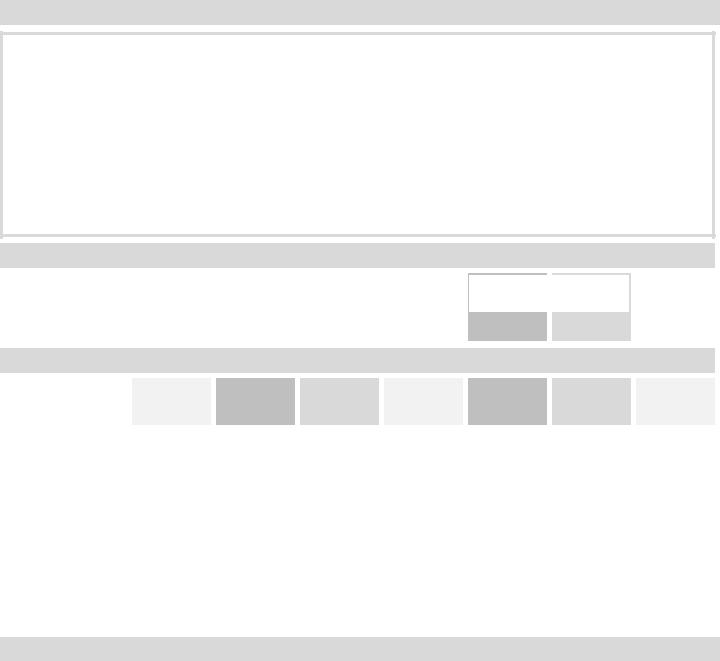
BRIGGS & STRATTON POWER PRODUCTS GROUP, LLC EQUIPMENT OWNER WARRANTY POLICY
LIMITED WARRANTY
Briggs & Stratton Power Products Group, LLC will repair or replace, free of charge, any part(s), of the equipment that is defective in material or workmanship or both. Transportation charges on parts submitted for repair or replacement under this warranty must be borne by purchaser. This warranty is effective for the time periods and subject to the conditions stated below. For warranty service, find the nearest Authorized
Service Dealer in our dealer locator map at www.briggspowerproducts.com.
THERE IS NO OTHER EXPRESS WARRANTY. IMPLIED WARRANTIES, INCLUDING THOSE OF MERCHANTABILITY AND FITNESS FOR A PARTICULAR PURPOSE, ARE LIMITED TO ONE YEAR FROM PURCHASE, OR TO THE EXTENT PERMITTED BY LAW ANY AND ALL IMPLIED WARRANTIES ARE EXCLUDED. LIABILITY FOR INCIDENTAL OR CONSEQUENTIAL DAMAGES ARE EXCLUDED TO THE
EXTENT EXCLUSION IS PERMITTED BY LAW. Some states or countries do not allow limitations on how long an implied warranty lasts, and some states or countries do not allow the exclusion or limitation of incidental or consequential damages, so the above limitation and exclusion may not apply to you. This warranty gives you specific legal rights and you may also have other rights which vary from state to state or country to country.
OUR EQUIPMENT*
|
|
OUTBOARD |
|
PRESSURE |
|
WATER PUMP |
|
PORTABLE |
|
HOME GENERATOR SYSTEM |
|
TRANSFER |
||
|
|
MOTOR |
|
WASHER |
|
(Not available in the |
|
GENERATOR |
|
(Includes Transfer Switch, if sold with equipment.) |
|
SWITCH |
||
|
|
|
|
|
|
USA) |
|
|
|
|
|
|
|
|
|
|
|
|
|
|
|
|
|
|
Less than 10 KW |
|
10 KW or greater |
|
|
|
|
|
|
|
|
|
|
|
|
|
|
|
|
|
WARRANTY PERIOD** |
|
|
|
|
|
|
|
|
|
|
|
|
||
|
2 years |
|
1 year |
|
1 year |
|
2 years |
|
2 years |
|
|
|
|
|
Consumer Use |
|
|
|
|
|
|
3 years or |
|
1 year |
|||||
Commercial Use |
|
none |
|
90 days |
|
90 days |
|
1 year |
|
1 year |
|
1500 hours |
|
|
|
|
|
|
|
|
|
|
|
||||||
|
|
|
|
|
|
|
|
|
|
|
|
|
|
|
*The engine and starting batteries are warranted solely by the manufacturers of those products.
**2 years for all consumer products in the European Union. Parts only on 2nd year for consumer use of Portable Generator and Home Generator System - Less than 10 KW, outside of European Union.
The warranty period begins on the date of purchase by the first retail consumer or commercial end user, and continues for the period of time stated in the table above. “Consumer use" means personal residential household use by a retail consumer. “Commercial use" means all otheruses, including use for commercial, income producing or rental purposes. Once equipment has experienced commercial use, it shall thereafter be considered as commercial use for purposes of this warranty. Equipment used for Prime Power in place of utility are not applicable to this warranty. Electric
Powered Pressure Washers used for commercial purposes are not warranted.
NO WARRANTY REGISTRATION IS NECESSARY TO OBTAIN WARRANTY ON BRIGGS & STRATTON PRODUCTS. SAVE YOUR PROOF OF PURCHASE RECEIPT. IF YOU DO NOT PROVIDE PROOF OF THE INITIAL PURCHASE DATE AT THE TIME WARRANTY SERVICE IS REQUESTED, THE MANUFACTURING DATE OF THE PRODUCT WILL BE USED TO DETERMINE THE WARRANTY PERIOD.
ABOUT YOUR EQUIPMENT WARRANTY
We welcome warranty repair and apologize to you for being inconvenienced. Any Authorized Service Dealer may perform warranty repairs. Most warranty repairs are handled routinely, but sometimes requests for warranty service may not be appropriate. For example, warranty service would not apply if equipment damage occurred because of misuse, lack of routine maintenance, shipping, handling, warehousing or improper installation. Similarly, the warranty is void if the manufacturing date or the serial number on the equipment has been removed or the equipment has been altered or modified. During the warranty period, the Authorized Service Dealer, at its option, will repair or replace any part that, upon examination, is found to be defective under normal use and service. This warranty will not cover the following repairs and equipment:
•Normal Wear: Outdoor Power Equipment, like all mechanical devices, needs periodic parts and service to perform well. This warranty does not cover repair when normal use has exhausted the life of a part or the equipment.
•Installation and Maintenance: This warranty does not apply to equipment or parts that have been subjected to improper or unauthorized installation or alteration and modification, misuse, negligence, accident, overloading, overspeeding, improper maintenance, repair or storage so as, in our judgment, to adversely affect its performance and reliability. This warranty also does not cover normal maintenance such as adjustments, fuel system cleaning and obstruction (due to chemical, dirt, carbon, lime, etc.).
•Other Exclusions: This warranty excludes wear items such as quick couplers, oil gauges, belts, o-rings, filters, pump packing, etc., pumps that have been run without water supplied or damage or malfunctions resulting from accidents, abuse, modifications, alterations, or improper servicing or freezing or chemical deterioration. Accessory parts such as guns, hoses, wands and nozzles are excluded from the product warranty. Also
excluded is used, reconditioned, and demonstration equipment; equipment used for prime power in place of utility power and equipment used in life support applications.
BRIGGS & STRATTON POWER PRODUCTS GROUP, LLC
JEFFERSON, WI, USA
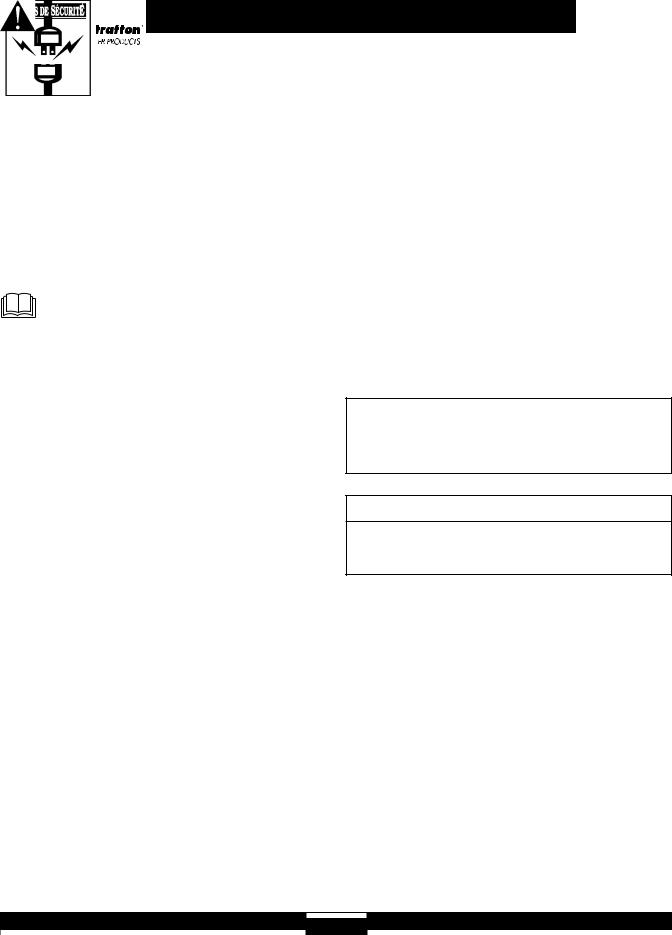
Génératrice portative
TABLE DES MATIÈRES
Règles de Sécurité . . . . . . . . . . . . . . . . . . . . . . . . . . . . . . . . 16-18 Assemblage . . . . . . . . . . . . . . . . . . . . . . . . . . . . . . . . . . . . . 19-21 Opération . . . . . . . . . . . . . . . . . . . . . . . . . . . . . . . . . . . . . . 22-25 Entretien. . . . . . . . . . . . . . . . . . . . . . . . . . . . . . . . . . . . . . . . . . 26 Rangement . . . . . . . . . . . . . . . . . . . . . . . . . . . . . . . . . . . . . . . . 27 Dépannage . . . . . . . . . . . . . . . . . . . . . . . . . . . . . . . . . . . . . . . . 28 Garantie . . . . . . . . . . . . . . . . . . . . . . . . . . . . . . . . . . . . . . . . . . 29
DESCRIPTION DE L ÉQUIPEMENT
Lisez avec soin ce manuel et familiarisez-vous avec votre générateur. Connaissez ses applications, ses limitations et les dangers qu'il implique.
Ce générateur est un générateur entraîné par un moteur à champ magnétique rotatif produisant du courant alternatif (c.a.). Il a été conçu pour fournir du courant électrique pour faire marcher des charges compatibles d'éclairage, d'appareils ménagers, d'outil et de moteur. Le champ tournant du générateur est entraîné à
3,600 T/M par un moteur monocylindrique.
ATTENTION! NE PAS dépasser la capacité en watts ou en Ampères du générateur.Voir "Ne Pas Surcharger le Générateur" sur la page 25 pour l'information spécifique.
Tout a été mis en oeuvre pour que les informations contenues dans ce manuel soient exactes et à jour. Cependant, nous se réserve le droit de changer, d'altérer ou d'améliorer le produit à n'importe quel moment sans avis préalable.
Le Système de contrôle de l'émission du générateur est garanti pour des normes établies par L'Agence de protection de l'environnement. Pour des informations sur la garantie, se reporter au manuel du moteur.
RÈGLES DE SÉCURITÉ
Ceci est la sûreté le symbole vif. Il est utilisé pour vous alerter aux dangers de blessure personnels potentiels. Obéir tous messages de sûreté qui suivent ce symbole éviter la blessure ou la mort possibles.
Le symbole indiquant un message de sécurité est accompagné d'un mot indicateur (DANGER,ATTENTION,AVERTISSEMENT), d'un message illustré et/ou d'un message de sécurité visant à vous avertir des dangers. DANGER indique un danger qui, s'il n'est pas évité, provoquera des blessures graves, voire fatales. AVERTISSEMENT indique un danger qui, s'il n'est pas évité, peut provoquer des blessures graves, voire fatales. ATTENTION indique un danger qui, s'il n'est pas évité, peut provoquer des blessures mineures ou légères. Le mot ATTENTION, lorsqu'il est utilisé sans le symbole d'alerte, indique une situation pouvant endommager l'équipement. Suivez les messages de sécurité pour éviter ou réduire les risques de blessures ou de mort.
Dans l'état de Californie un pare-étincelles est requis par la loi (section 4442 du Code des ressources publiques de Californie). D'autres états ont des lois similaires. Les lois fédérales s'appliquent aux terres fédérales. Si vous équipez le silencieux d'un pare-étincelles, il doit être en bon état de fonctionnement.
 AVERTISSEMENT
AVERTISSEMENT
L’échappement du moteur de ce produit contient des produits chimiques que l’État de Californie considère comme causant le cancer, des déformations à la naissance ou d’autres dangers concernant la reproduction.
16
